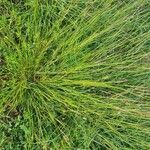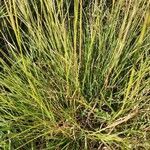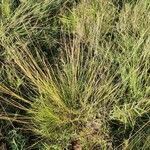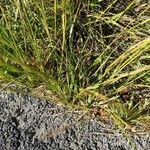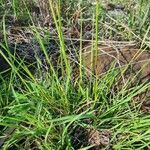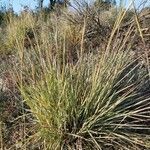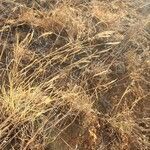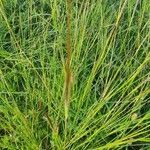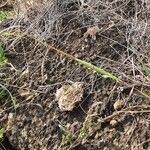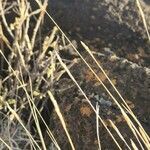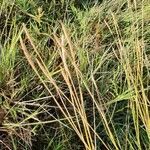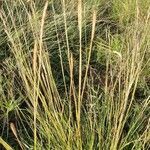Rhizomatous perennial, 0.2-1.0 m high. Leaf blade 30-300 x 3-8 mm, usually folded, apex rounded, often hooded; ligule a fringed membrane. Inflorescence a single, spikelike raceme with velvety awns in upper half only; racemes linear with spikelet pairs in lower 1/4 or 3/4 homogamous (alike in sex and shape), spikelet pairs in upper portion heterogamous (differing in sex and shape); internodes linear; spikelets paired: one sessile, the other pedicelled but pedicel reduced to a short stump and spikelets are supported on a long callus. Sessile spikelet 5.5-7.0 mm long; glumes ± equal. Florets 2; lower floret reduced to a lemma, hyaline, awnless; upper floret bisexual or female in heterogamous pair, or sterile in homogamous pair; lemma stipiform, passing into a stout, hairy, geniculate awn, awn 50-80 mm long. Pedicelled spikelet 8-13 mm long, dorsally flattened, somewhat asymmetrical, larger than sessile spikelet, male or sterile, awnless, with long slender callus functioning as a pedicel, true pedicel reduced to a stump; anther 3.0-3.5 mm long. Flowering time Oct.-June.
Perennial. Culms slender, tufted, usually geniculate at base, 20–100 cm tall. Leaf sheaths keeled; leaf blades flat or folded, 10–20 × 0.3–0.6 cm, scabrid or adaxial surface pilose at base, apex obtuse or shortly acute to apiculate; ligule ciliate along margin. Inflorescence terminal or racemes gathered into a scanty panicle; spatheoles linear, tightly rolled around peduncle; peduncles mostly long-exserted. Racemes 3–7 cm (excluding awns), narrowly cylindrical, 7–12-awned, (1–)3–10(–12) pairs of flat green homogamous spikelets below the awned fertile pairs. Sessile spikelet 5–7 mm, dark brown; callus 2–3 mm, fiercely pungent, brown bearded; lower glume linear becoming cylindrical at maturity, sometimes hispidulous between veins; awn 6–10 cm, dark brown, column white-hirtellous, tips of successive awns often twisting together. Pedicelled spikelet 6–11 mm, lower glume oblong-lanceolate, greenish, laterally asymmetrically winged, glabrous or sparsely to densely pilose or tuberculate-hispid or white setose. Fl. and fr. Apr–Dec. 2n = 20, 40, 44, 50, 60, 80.
Untidily tufted perennial, the basal sheaths laterally compressed; culms 30–100 cm. high, erect.. Leaf-blades flat, 3–30 cm. long, 2–8 mm. wide, abruptly narrowed at the tip.. Racemes 3–10 cm. long, mostly long-exserted, solitary or aggregated into a scanty false panicle, the awns forming a twisted spire.. Homogamous pairs 3–17, resembling the pedicelled spikelets.. Sessile spikelet 5.5–10 mm. long, including a ferociously pungent and rufously bearded callus 2–3 mm. long; lower glume elliptic-oblong, brown, hispidulous; awn 5–8 cm. long, hirtellous.. Pedicelled spikelet 5–15 mm. long; lower glume green with yellowish membranous margins, without glands, the hairiness varying from glabrous to tuberculate-villous; callus 2–3 mm. long.. Fig. 191.
Perennial 200-1000 mm high; rhizome present. Leaf blade 30-300 x 3-8 mm, usually folded, apex rounded and often hooded; ligule a fringed membrane. Inflorescence a single spike-like raceme with velvety awns in the upper half only; spathes without glands. Sessile spikelet 5.5-7.0 mm long. Pedicelled spikelet 8-13 mm long, glandless; anthers 3.0-3.5 mm long.
Perennial, rhizomatous, up to 1 m high.-Leaf blades 30-300 mm long, 3-8 mm wide. Leaves usually folded, tips rounded and often hooded. Spikelets (sessile) 5.5-7.0 mm long (pedicellate 8-13 mm long and glandless). Inflorescence a single spike with velvety awns from upper half.
Perennial; up to 1 m high; rhizomatous. Leaf blades 30-300 x 3-8 mm; leaves usually folded; apices rounded and often hooded. Flowers: in a single spike with velvety awns from upper half; sessile spikelets 5.5-7.0 mm long; pedicellate spikelets 8-13 mm long and eglandular.
Racemes 3–10 cm long, mostly long-exserted, solitary or aggregated into a scanty false panicle, the awns eventually twisted together into a terminal spire; homogamous spikelet pairs 3–17, resembling the pedicelled spikelets.
Sessile spikelet 5.5–10 mm long (including the ferociously pungent and rufously barbate callus 2–3 mm long); inferior glume elliptic-oblong, brown, hispidulous; awn 5–8 cm long, hirtellous.
Pedicelled spikelet 5–15 mm long; inferior glume green with yellowish membranous margins, without glands, the indumentum ranging from absent to tuberculate-villous; callus 2–3 mm long.
Rhizomatous perennial to 70 cm. Leaves linear. Spikelets in a spike-like raceme, the upper awned, awns twisted together above spikelets.
Awns twisted into a spire when young, and forming a malignant tangled knot at maturity; callus painfully pungent.
Caespitose perennial with laterally compressed leaf sheaths; culms up to 100 cm high, erect.
Leaf laminas 3–30 cm × 2–8 mm, abruptly narrowed at the apex.
Perennial, up to about 1 m. high
